Nhiễm trùng hô hấp dưới cấp tính ở cộng đồng do tác nhân vi sinh gây bệnh khó điều trị
Nhiễm trùng hô hấp dưới (NTHHD) cấp tính ở cộng đồng là nguyên nhân bệnh tật và tử vong hàng đầu ở
cả trẻ em và người lớn. Gánh nặng bệnh tật do nhóm bệnh lý này (không kể lao) gây ra lớn hơn HIV, sốt rét, ung thư hay sự cố tim.

Trang 1
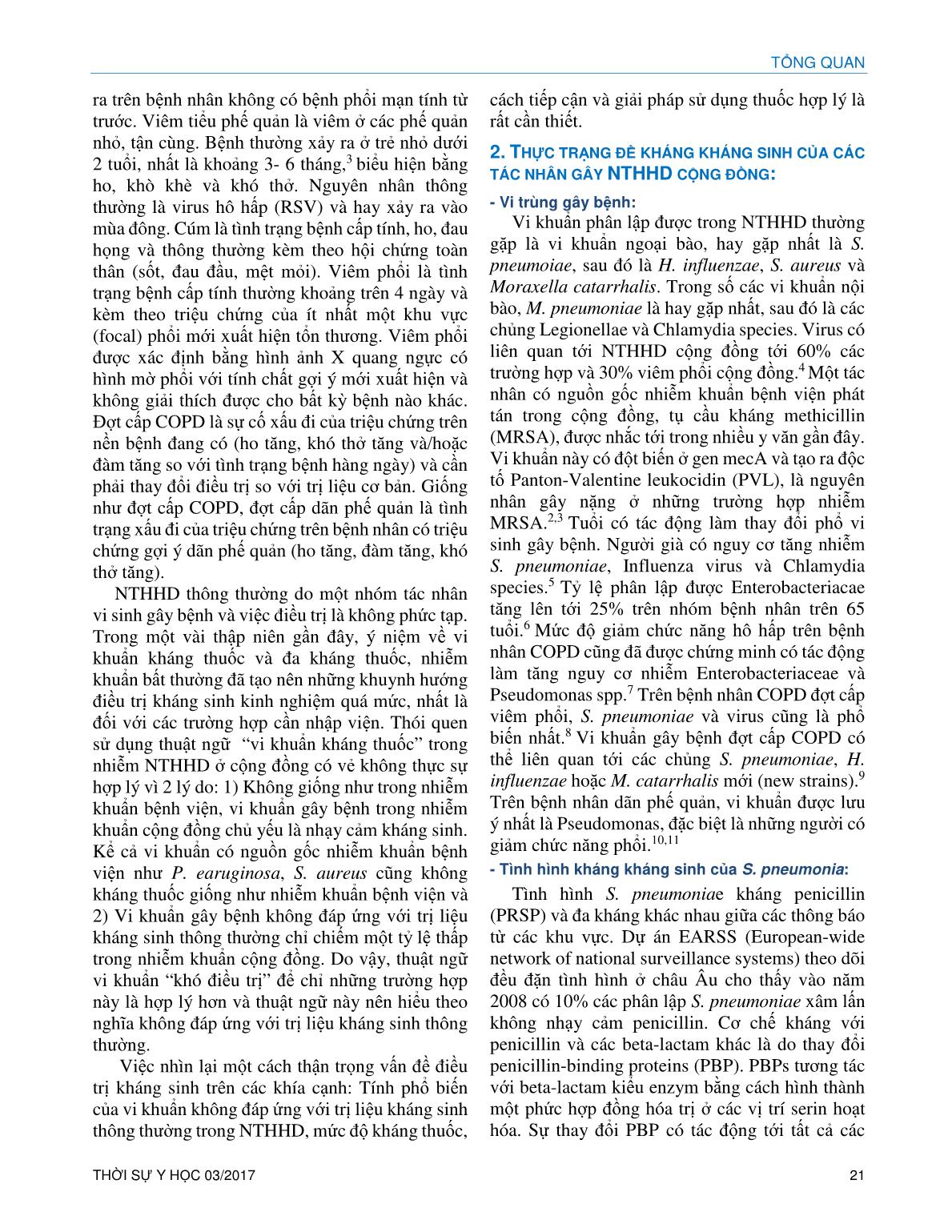
Trang 2
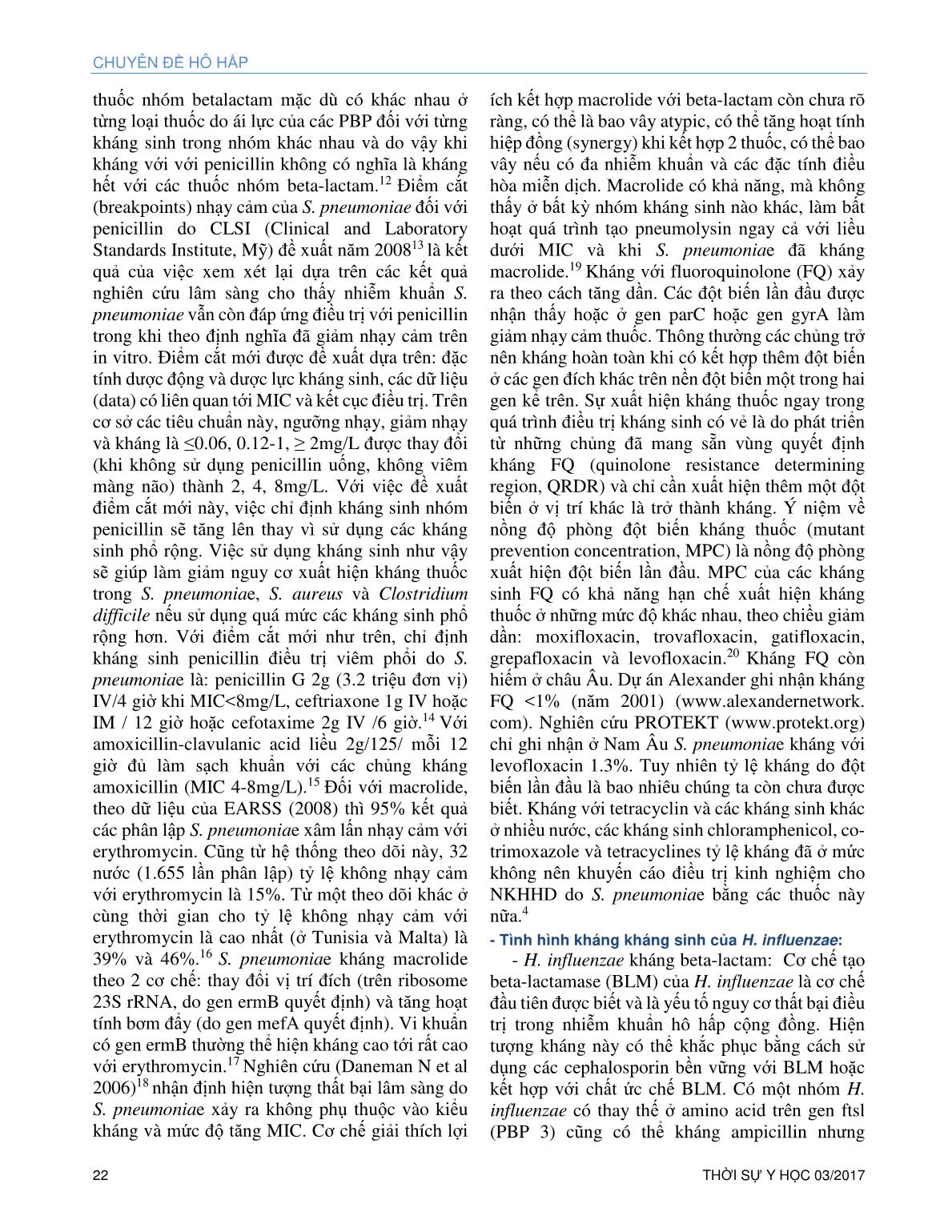
Trang 3
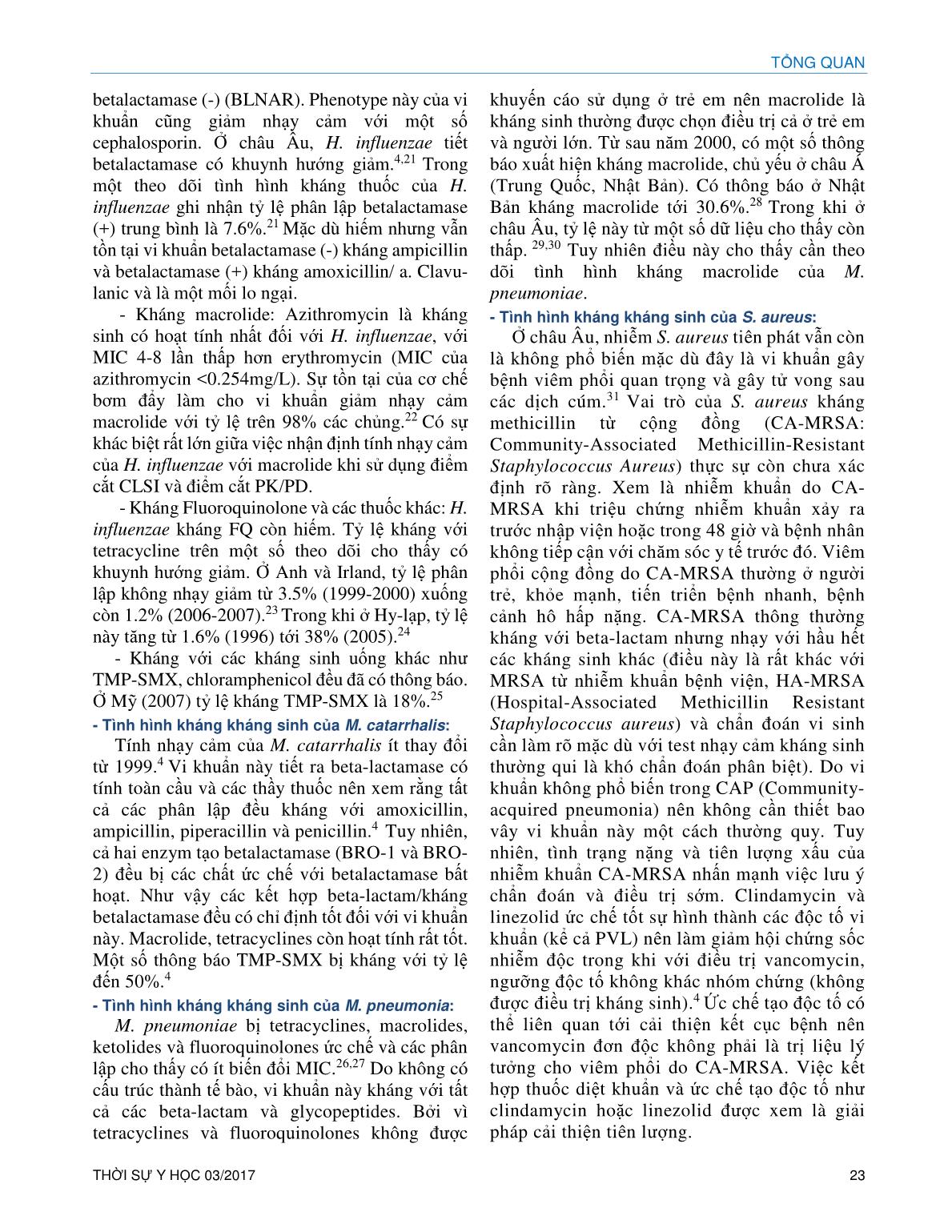
Trang 4
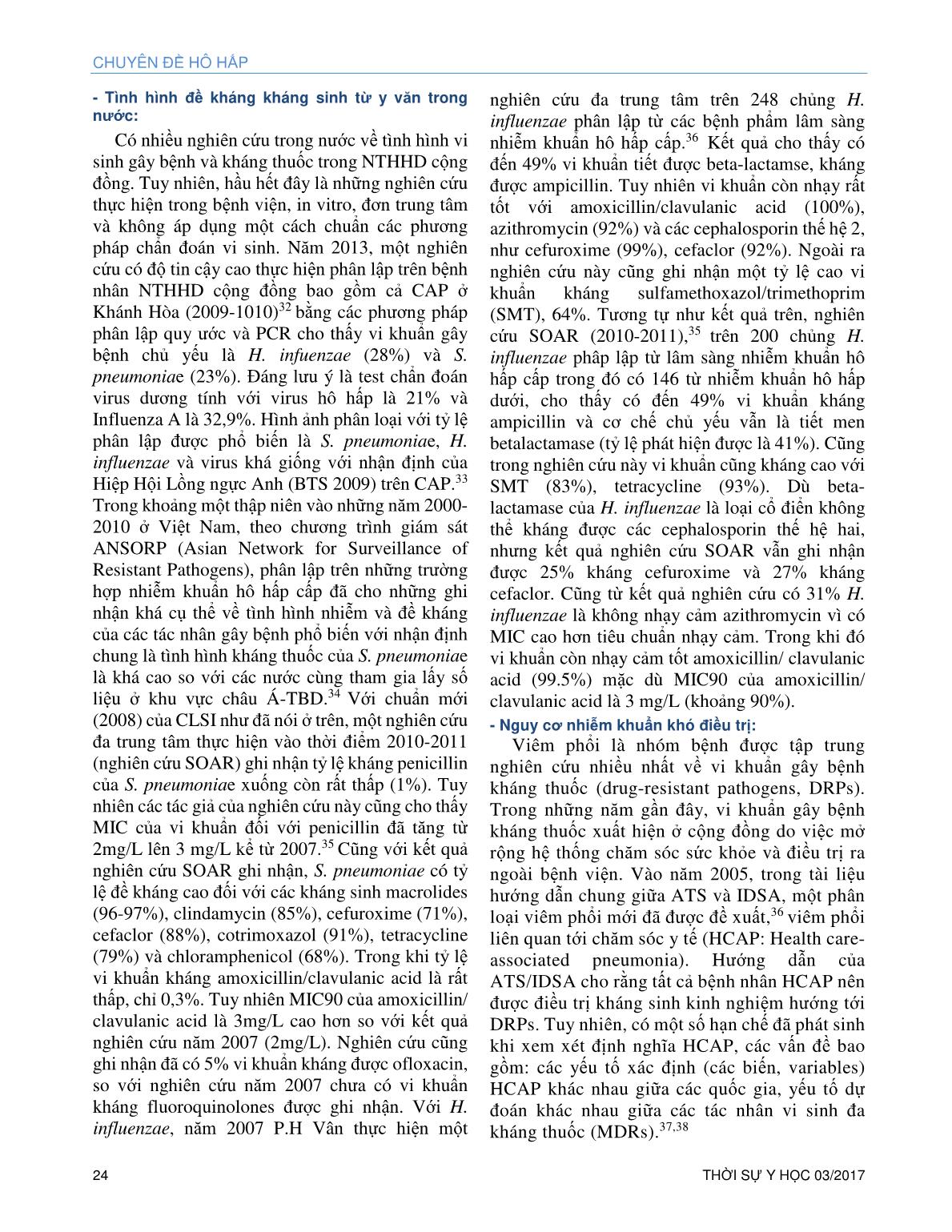
Trang 5
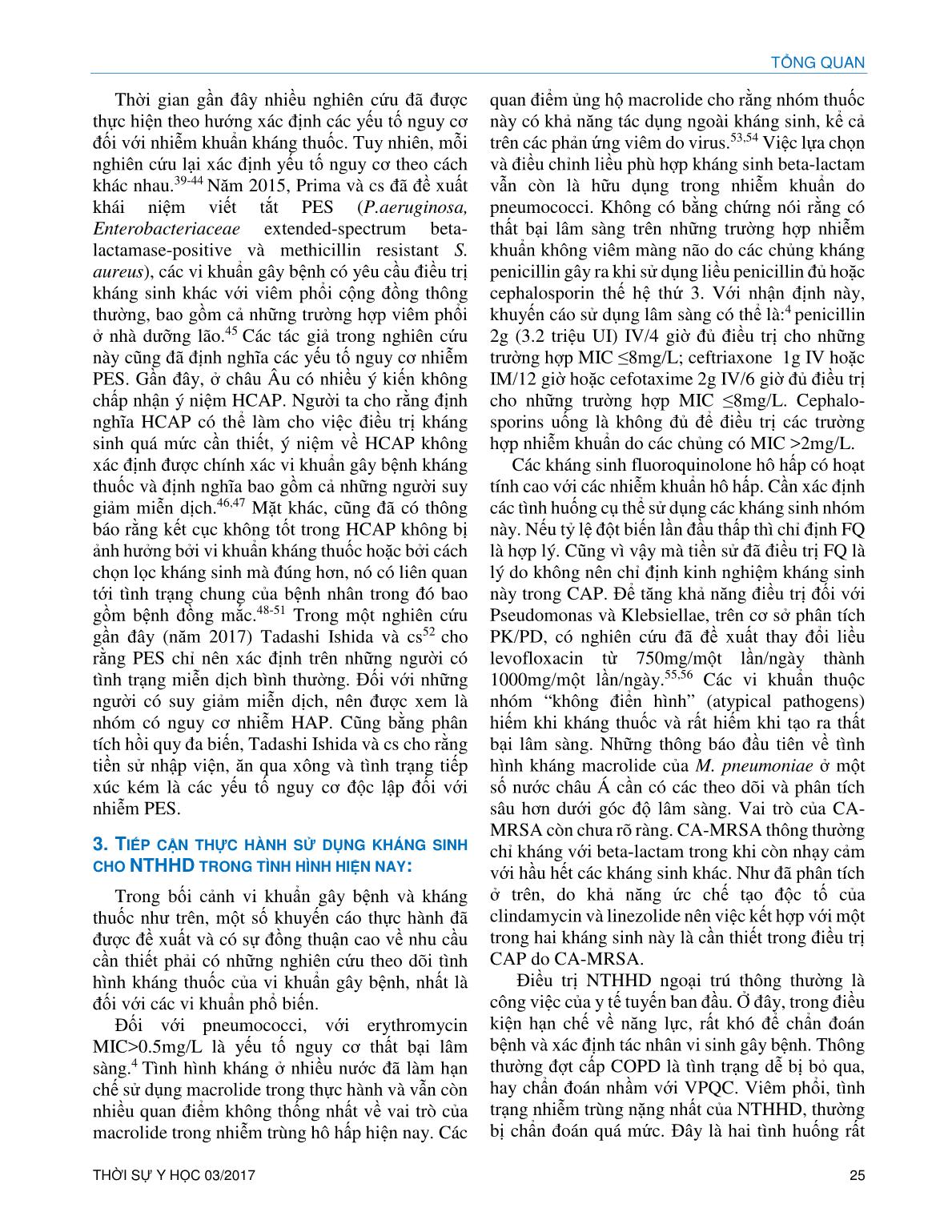
Trang 6
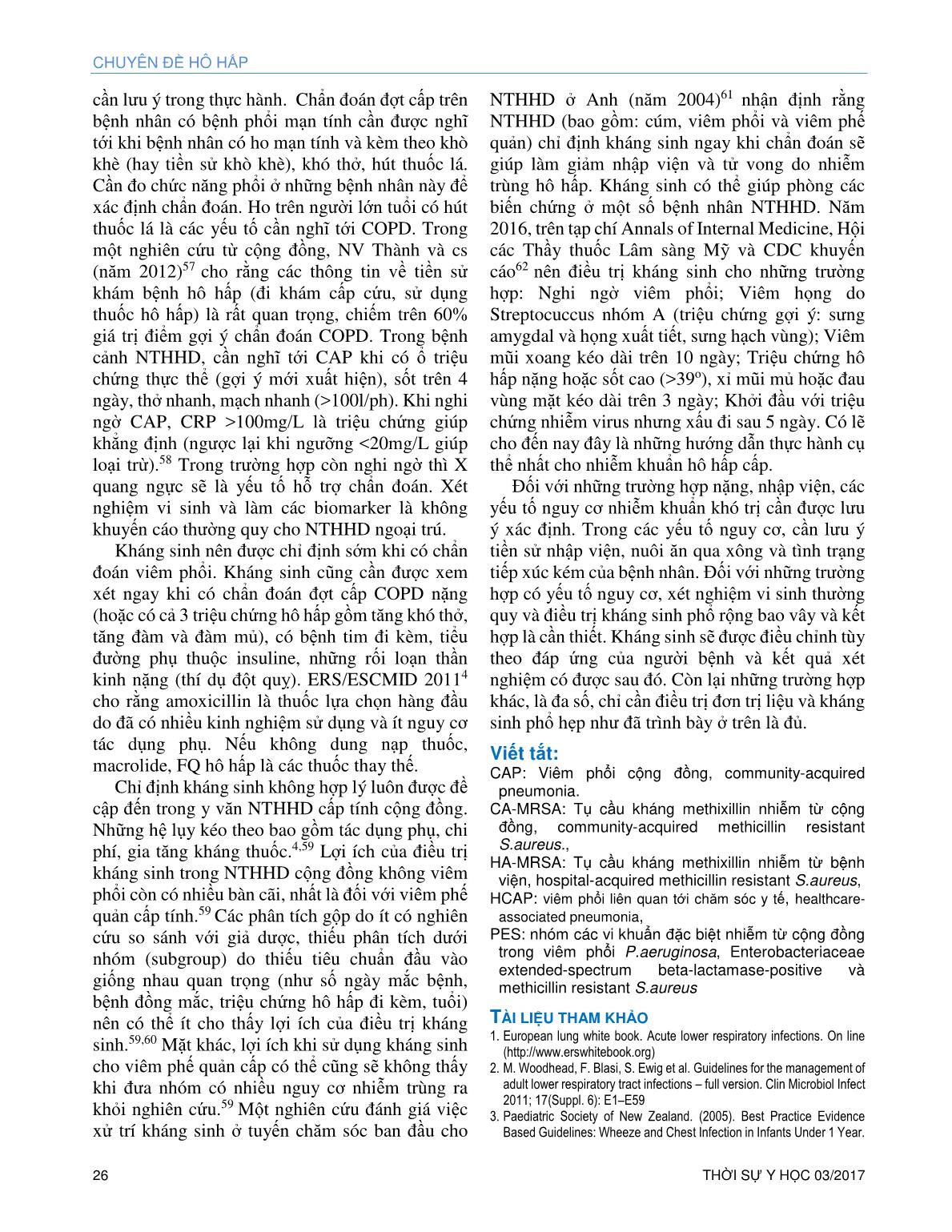
Trang 7
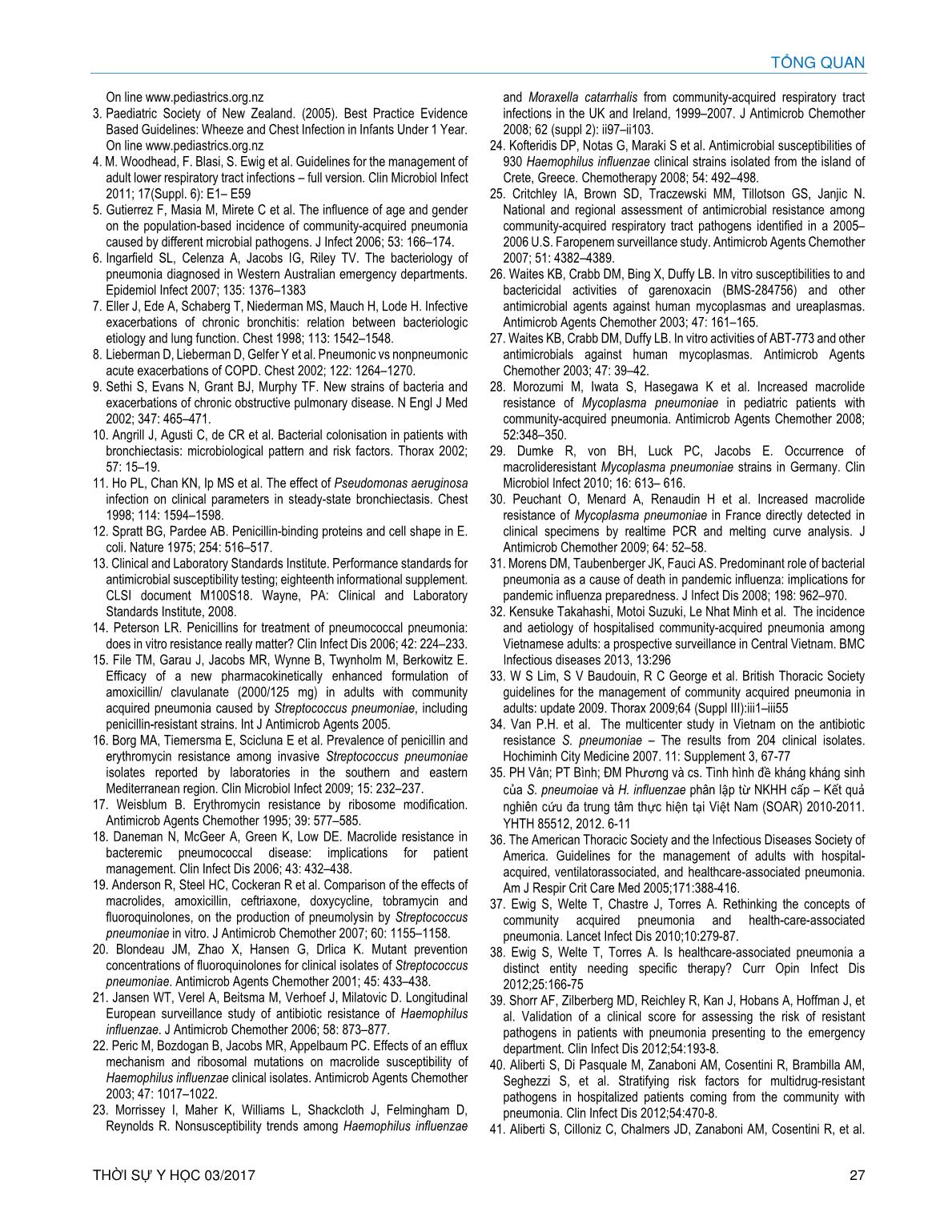
Trang 8
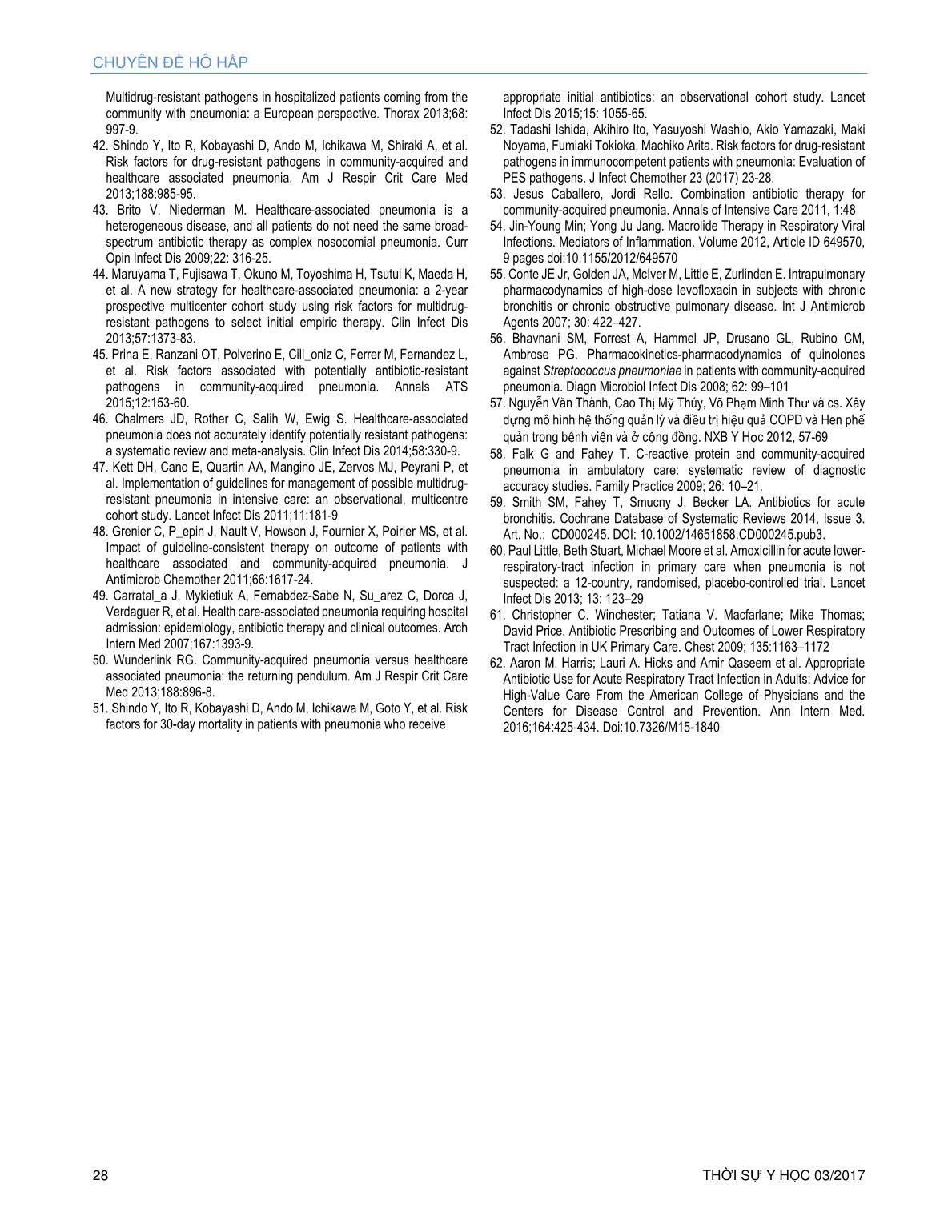
Trang 9
Bạn đang xem tài liệu "Nhiễm trùng hô hấp dưới cấp tính ở cộng đồng do tác nhân vi sinh gây bệnh khó điều trị", để tải tài liệu gốc về máy hãy click vào nút Download ở trên
Tóm tắt nội dung tài liệu: Nhiễm trùng hô hấp dưới cấp tính ở cộng đồng do tác nhân vi sinh gây bệnh khó điều trị

CHUYÊN ĐỀ HÔ HẤP 20 THỜI SỰ Y HỌC 03/2017 NHIỄM TRÙNG HÔ HẤP DƯỚI CẤP TÍNH Ở CỘNG ĐỒNG DO TÁC NHÂN VI SINH GÂY BỆNH KHÓ ĐIỀU TRỊ Nguyễn Văn Thành* TÓM TẮT: Nhiễm trùng hô hấp dưới (NTHHD) cấp tính ở cộng đồng là nguyên nhân bệnh tật và tử vong hàng đầu ở cả trẻ em và người lớn. Gánh nặng bệnh tật do nhóm bệnh lý này (không kể lao) gây ra lớn hơn HIV, sốt rét, ung thư hay sự cố tim. Ở Mỹ, nhóm bệnh này gây bệnh tật và tử vong nhiều hơn bất kỳ bệnh nhiễm trùng nào và tỷ lệ tử vong ít thay đổi trong khoảng 5 thập niên vừa qua. Tiếp nhận và xử trí NTHHD là câu chuyện hàng ngày của y tế cơ sở và xử trí chủ yếu là kháng sinh để giải quyết nhiễm khuẩn. Đã một thời gian dài, việc xử trí bằng kháng sinh một cách thường quy như vậy được xem là hợp lý vì cho rằng có thể giúp phòng các biến chứng sau đó. Tuy nhiên, các biến chứng của NTHHD cấp tính được đánh giá là thấp và không có bằng chứng thuyết phục để kết luận rằng sử dụng kháng sinh ít sẽ làm gia tăng biến chứng. Bên cạnh những hệ lụy về việc sử dụng kháng sinh quá mức, không hợp lý, đã có bằng chứng cho rằng kháng thuốc có liên quan chặt chẽ với tình hình sử dụng kháng sinh ở hệ thống y tế chăm sóc ban đầu. Xuất phát điểm từ vi sinh gây bệnh, bài trình bày cung cấp một cách nhìn cụ thể, cần thiết và cập nhật về tình hình kháng thuốc của vi sinh gây bệnh phổ biến và những tác nhân vi sinh gây bệnh đặc biệt. Trên cơ sở này tác giả muốn xác định các quan điểm điều trị kháng sinh cần thiết và hợp lý trong thực hành, nhất là ở tuyến y tế ban đầu. Từ khóa: Nhiễm trùng hô hấp dưới, viêm phổi cộng đồng, đợt cấp COPD, vi khuẩn kháng thuốc ABSTRACT: ACUTE LOWER RESPIRATORY TRACT INFECTIONS IN COMMUNITY CAUSED BY DIFFICULT-TO-TREAT MICROBIAL PATHOGENS Lower respiratory infections (LRTI) in community is the a leading cause of acute disease and death in both children and adults. The burden of disease caused by this pathology group (excluding tuberculosis) greater than that caused by HIV, malaria, cancer or heart trouble. In America this pathology cause morbidity and mortality more than any other infections and mortality does not change for about 5 decades. Receiving and handling LRTI patient is the daily work of the primary medical setting and management *TS.BS PCT Hội Lao và bệnh phổi Việt Nam. E-mail: thanhbk@hcm.vnn.vn mainly is antibiotics in order to treat infections. A long time ago, the routine use of antibiotic by such way seems reasonable because think that may help prevent later complications. However, complications of acute LRTI is assessed to be low and there is no convincing evidence to conclude that the less use of antibiotics increases complications. Besides the implications of the use of antibiotics excessive, unreasonable, there were the evidences that the drug resistance is closely related to the use of antibiotics in the initial health care system. Beginning from pathogenic microorganism, this presentation provides a specific perspective, necessary and updated on antibiotic resistance situation of common and particular pathogenic microbial pathogens. On this basis the author wanted to determine the views of antibiotic treatment necessary and reasonable in practice, especially at the initial health care. Key words: Lower respiratory tract infection, Community-acquired pneumonia, Acute exacerbation of COPD, Antibiotic resistant bacteria. 1. ĐẶT VẤN ĐỀ: Nhiễm trùng hô hấp dưới (NTHHD) cấp tính ở cộng đồng là nguyên nhân bệnh tật và tử vong hàng đầu ở cả trẻ em và người lớn.1 Tuy nhiên, nhóm bệnh lý này thường được định nghĩa không thống nhất và do vậy nhận định về tình hình mắc và gánh nặng bệnh tật cũng rất khác nhau, nhất là phần lớn các trường hợp được chăm sóc bởi tuyến y tế ban đầu và không trong bệnh viện. Với thuật ngữ NTHHD cấp tính ở cộng đồng, bệnh lý này thường được hiểu bao gồm viêm cấp tính phế quản, viêm tiểu phế quản, cúm và viêm phổi.1 Tài liệu hướng dẫn (guidelines) của Hội Hô hấp châu Âu và hội Vi sinh lâm sàng châu Âu (ERS/ESCMID) (năm 2011)2 đưa thêm vào cả đợt cấp bệnh phổi tắc nghẽn mạn tính (COPD) và đợt cấp dãn phế quản. Nhiễm trùng hô hấp dưới cấp tính là tình trạng lâm sàng cấp tính, thông thường trong khoảng 3 tuần với triệu chứng ho, có hay không triệu chứng khác như khạc đàm, khó thở, khò khè, đau ngực. Các triệu chứng này không giải thích được cho bệnh nào khác (thí dụ như viêm xoang, hen).2 Viêm phế quản cấp là tình trạng bệnh cấp tính xảy TỔNG QUAN THỜI SỰ Y HỌC 03/2017 21 ra trên bệnh nhân không có bệnh phổi mạn tính từ trước. Viêm tiểu phế quản là viêm ở các phế quản nhỏ, tận cùng. Bệnh thường xảy ra ở trẻ nhỏ dưới 2 tuổi, nhất là khoảng 3- 6 tháng,3 biểu hiện bằng ho, khò khè và khó thở. Nguyên nhân thông thường là virus hô hấp (RSV) và hay xảy ra vào mùa đông. Cúm là tình trạng bệnh cấp tính, ho, đau họng và thông thường kèm theo hội chứng toàn thân (sốt, đau đầu, mệt mỏi). Viêm phổi là tình trạng bệnh cấp tính thường khoảng trên 4 ngày và kèm theo triệu chứng của ít nhất một khu vực (focal) phổi mới xuất hiện tổn thương. Viêm phổi được xác định bằng hình ảnh X quang ngực có hình mờ phổi với tính chất gợi ý mới xuất hiện và không giải thích được cho bất kỳ bệnh nào khác. Đợt cấp COPD là sự cố xấu đi của triệu chứng trên nền bệnh đang có (ho tăng, khó thở tăng và/hoặc đàm tăng so với tình trạng bệnh hàng ngày) và cần phải thay đổi điều trị so với trị liệu cơ bản. Giống như đợt cấp COPD, đợt cấp dãn phế quản là tình trạng xấu đi của triệu chứng trên bệnh nhân có triệu chứng gợi ý dãn phế quản (ho tăng, đàm tăng, khó thở tăng). NTHHD thông thường do một nhóm tác nhân vi sinh gây bệnh và việc điều trị là không phức tạp. Trong một vài thập niên gần đây, ý niệm về vi khuẩn kháng thuốc và đa kháng thuốc, nhiễm khuẩn bất thường đã tạo nên những khuynh hướng đi ... g methixillin nhiễm từ cộng đồng, community-acquired methicillin resistant S.aureus., HA-MRSA: Tụ cầu kháng methixillin nhiễm từ bệnh viện, hospital-acquired methicillin resistant S.aureus, HCAP: viêm phổi liên quan tới chăm sóc y tế, healthcare- associated pneumonia, PES: nhóm các vi khuẩn đặc biệt nhiễm từ cộng đồng trong viêm phổi P.aeruginosa, Enterobacteriaceae extended-spectrum beta-lactamase-positive và methicillin resistant S.aureus TÀI LIỆU THAM KHẢO 1. European lung white book. Acute lower respiratory infections. On line ( 2. M. Woodhead, F. Blasi, S. Ewig et al. Guidelines for the management of adult lower respiratory tract infections – full version. Clin Microbiol Infect 2011; 17(Suppl. 6): E1–E59 3. Paediatric Society of New Zealand. (2005). Best Practice Evidence Based Guidelines: Wheeze and Chest Infection in Infants Under 1 Year. TỔNG QUAN THỜI SỰ Y HỌC 03/2017 27 On line www.pediastrics.org.nz 3. Paediatric Society of New Zealand. (2005). Best Practice Evidence Based Guidelines: Wheeze and Chest Infection in Infants Under 1 Year. On line www.pediastrics.org.nz 4. M. Woodhead, F. Blasi, S. Ewig et al. Guidelines for the management of adult lower respiratory tract infections – full version. Clin Microbiol Infect 2011; 17(Suppl. 6): E1– E59 5. Gutierrez F, Masia M, Mirete C et al. The influence of age and gender on the population-based incidence of community-acquired pneumonia caused by different microbial pathogens. J Infect 2006; 53: 166–174. 6. Ingarfield SL, Celenza A, Jacobs IG, Riley TV. The bacteriology of pneumonia diagnosed in Western Australian emergency departments. Epidemiol Infect 2007; 135: 1376–1383 7. Eller J, Ede A, Schaberg T, Niederman MS, Mauch H, Lode H. Infective exacerbations of chronic bronchitis: relation between bacteriologic etiology and lung function. Chest 1998; 113: 1542–1548. 8. Lieberman D, Lieberman D, Gelfer Y et al. Pneumonic vs nonpneumonic acute exacerbations of COPD. Chest 2002; 122: 1264–1270. 9. Sethi S, Evans N, Grant BJ, Murphy TF. New strains of bacteria and exacerbations of chronic obstructive pulmonary disease. N Engl J Med 2002; 347: 465–471. 10. Angrill J, Agusti C, de CR et al. Bacterial colonisation in patients with bronchiectasis: microbiological pattern and risk factors. Thorax 2002; 57: 15–19. 11. Ho PL, Chan KN, Ip MS et al. The effect of Pseudomonas aeruginosa infection on clinical parameters in steady-state bronchiectasis. Chest 1998; 114: 1594–1598. 12. Spratt BG, Pardee AB. Penicillin-binding proteins and cell shape in E. coli. Nature 1975; 254: 516–517. 13. Clinical and Laboratory Standards Institute. Performance standards for antimicrobial susceptibility testing; eighteenth informational supplement. CLSI document M100S18. Wayne, PA: Clinical and Laboratory Standards Institute, 2008. 14. Peterson LR. Penicillins for treatment of pneumococcal pneumonia: does in vitro resistance really matter? Clin Infect Dis 2006; 42: 224–233. 15. File TM, Garau J, Jacobs MR, Wynne B, Twynholm M, Berkowitz E. Efficacy of a new pharmacokinetically enhanced formulation of amoxicillin/ clavulanate (2000/125 mg) in adults with community acquired pneumonia caused by Streptococcus pneumoniae, including penicillin-resistant strains. Int J Antimicrob Agents 2005. 16. Borg MA, Tiemersma E, Scicluna E et al. Prevalence of penicillin and erythromycin resistance among invasive Streptococcus pneumoniae isolates reported by laboratories in the southern and eastern Mediterranean region. Clin Microbiol Infect 2009; 15: 232–237. 17. Weisblum B. Erythromycin resistance by ribosome modification. Antimicrob Agents Chemother 1995; 39: 577–585. 18. Daneman N, McGeer A, Green K, Low DE. Macrolide resistance in bacteremic pneumococcal disease: implications for patient management. Clin Infect Dis 2006; 43: 432–438. 19. Anderson R, Steel HC, Cockeran R et al. Comparison of the effects of macrolides, amoxicillin, ceftriaxone, doxycycline, tobramycin and fluoroquinolones, on the production of pneumolysin by Streptococcus pneumoniae in vitro. J Antimicrob Chemother 2007; 60: 1155–1158. 20. Blondeau JM, Zhao X, Hansen G, Drlica K. Mutant prevention concentrations of fluoroquinolones for clinical isolates of Streptococcus pneumoniae. Antimicrob Agents Chemother 2001; 45: 433–438. 21. Jansen WT, Verel A, Beitsma M, Verhoef J, Milatovic D. Longitudinal European surveillance study of antibiotic resistance of Haemophilus influenzae. J Antimicrob Chemother 2006; 58: 873–877. 22. Peric M, Bozdogan B, Jacobs MR, Appelbaum PC. Effects of an efflux mechanism and ribosomal mutations on macrolide susceptibility of Haemophilus influenzae clinical isolates. Antimicrob Agents Chemother 2003; 47: 1017–1022. 23. Morrissey I, Maher K, Williams L, Shackcloth J, Felmingham D, Reynolds R. Nonsusceptibility trends among Haemophilus influenzae and Moraxella catarrhalis from community-acquired respiratory tract infections in the UK and Ireland, 1999–2007. J Antimicrob Chemother 2008; 62 (suppl 2): ii97–ii103. 24. Kofteridis DP, Notas G, Maraki S et al. Antimicrobial susceptibilities of 930 Haemophilus influenzae clinical strains isolated from the island of Crete, Greece. Chemotherapy 2008; 54: 492–498. 25. Critchley IA, Brown SD, Traczewski MM, Tillotson GS, Janjic N. National and regional assessment of antimicrobial resistance among community-acquired respiratory tract pathogens identified in a 2005– 2006 U.S. Faropenem surveillance study. Antimicrob Agents Chemother 2007; 51: 4382–4389. 26. Waites KB, Crabb DM, Bing X, Duffy LB. In vitro susceptibilities to and bactericidal activities of garenoxacin (BMS-284756) and other antimicrobial agents against human mycoplasmas and ureaplasmas. Antimicrob Agents Chemother 2003; 47: 161–165. 27. Waites KB, Crabb DM, Duffy LB. In vitro activities of ABT-773 and other antimicrobials against human mycoplasmas. Antimicrob Agents Chemother 2003; 47: 39–42. 28. Morozumi M, Iwata S, Hasegawa K et al. Increased macrolide resistance of Mycoplasma pneumoniae in pediatric patients with community-acquired pneumonia. Antimicrob Agents Chemother 2008; 52:348–350. 29. Dumke R, von BH, Luck PC, Jacobs E. Occurrence of macrolideresistant Mycoplasma pneumoniae strains in Germany. Clin Microbiol Infect 2010; 16: 613– 616. 30. Peuchant O, Menard A, Renaudin H et al. Increased macrolide resistance of Mycoplasma pneumoniae in France directly detected in clinical specimens by realtime PCR and melting curve analysis. J Antimicrob Chemother 2009; 64: 52–58. 31. Morens DM, Taubenberger JK, Fauci AS. Predominant role of bacterial pneumonia as a cause of death in pandemic influenza: implications for pandemic influenza preparedness. J Infect Dis 2008; 198: 962–970. 32. Kensuke Takahashi, Motoi Suzuki, Le Nhat Minh et al. The incidence and aetiology of hospitalised community-acquired pneumonia among Vietnamese adults: a prospective surveillance in Central Vietnam. BMC Infectious diseases 2013, 13:296 33. W S Lim, S V Baudouin, R C George et al. British Thoracic Society guidelines for the management of community acquired pneumonia in adults: update 2009. Thorax 2009;64 (Suppl III):iii1–iii55 34. Van P.H. et al. The multicenter study in Vietnam on the antibiotic resistance S. pneumoniae – The results from 204 clinical isolates. Hochiminh City Medicine 2007. 11: Supplement 3, 67-77 35. PH Vân; PT Bình; ĐM Phương và cs. Tình hình đề kháng kháng sinh của S. pneumoiae và H. influenzae phân lập từ NKHH cấp – Kết quả nghiên cứu đa trung tâm thực hiện tại Việt Nam (SOAR) 2010-2011. YHTH 85512, 2012. 6-11 36. The American Thoracic Society and the Infectious Diseases Society of America. Guidelines for the management of adults with hospital- acquired, ventilatorassociated, and healthcare-associated pneumonia. Am J Respir Crit Care Med 2005;171:388-416. 37. Ewig S, Welte T, Chastre J, Torres A. Rethinking the concepts of community acquired pneumonia and health-care-associated pneumonia. Lancet Infect Dis 2010;10:279-87. 38. Ewig S, Welte T, Torres A. Is healthcare-associated pneumonia a distinct entity needing specific therapy? Curr Opin Infect Dis 2012;25:166-75 39. Shorr AF, Zilberberg MD, Reichley R, Kan J, Hobans A, Hoffman J, et al. Validation of a clinical score for assessing the risk of resistant pathogens in patients with pneumonia presenting to the emergency department. Clin Infect Dis 2012;54:193-8. 40. Aliberti S, Di Pasquale M, Zanaboni AM, Cosentini R, Brambilla AM, Seghezzi S, et al. Stratifying risk factors for multidrug-resistant pathogens in hospitalized patients coming from the community with pneumonia. Clin Infect Dis 2012;54:470-8. 41. Aliberti S, Cilloniz C, Chalmers JD, Zanaboni AM, Cosentini R, et al. CHUYÊN ĐỀ HÔ HẤP 28 THỜI SỰ Y HỌC 03/2017 Multidrug-resistant pathogens in hospitalized patients coming from the community with pneumonia: a European perspective. Thorax 2013;68: 997-9. 42. Shindo Y, Ito R, Kobayashi D, Ando M, Ichikawa M, Shiraki A, et al. Risk factors for drug-resistant pathogens in community-acquired and healthcare associated pneumonia. Am J Respir Crit Care Med 2013;188:985-95. 43. Brito V, Niederman M. Healthcare-associated pneumonia is a heterogeneous disease, and all patients do not need the same broad- spectrum antibiotic therapy as complex nosocomial pneumonia. Curr Opin Infect Dis 2009;22: 316-25. 44. Maruyama T, Fujisawa T, Okuno M, Toyoshima H, Tsutui K, Maeda H, et al. A new strategy for healthcare-associated pneumonia: a 2-year prospective multicenter cohort study using risk factors for multidrug- resistant pathogens to select initial empiric therapy. Clin Infect Dis 2013;57:1373-83. 45. Prina E, Ranzani OT, Polverino E, Cill_oniz C, Ferrer M, Fernandez L, et al. Risk factors associated with potentially antibiotic-resistant pathogens in community-acquired pneumonia. Annals ATS 2015;12:153-60. 46. Chalmers JD, Rother C, Salih W, Ewig S. Healthcare-associated pneumonia does not accurately identify potentially resistant pathogens: a systematic review and meta-analysis. Clin Infect Dis 2014;58:330-9. 47. Kett DH, Cano E, Quartin AA, Mangino JE, Zervos MJ, Peyrani P, et al. Implementation of guidelines for management of possible multidrug- resistant pneumonia in intensive care: an observational, multicentre cohort study. Lancet Infect Dis 2011;11:181-9 48. Grenier C, P_epin J, Nault V, Howson J, Fournier X, Poirier MS, et al. Impact of guideline-consistent therapy on outcome of patients with healthcare associated and community-acquired pneumonia. J Antimicrob Chemother 2011;66:1617-24. 49. Carratal_a J, Mykietiuk A, Fernabdez-Sabe N, Su_arez C, Dorca J, Verdaguer R, et al. Health care-associated pneumonia requiring hospital admission: epidemiology, antibiotic therapy and clinical outcomes. Arch Intern Med 2007;167:1393-9. 50. Wunderlink RG. Community-acquired pneumonia versus healthcare associated pneumonia: the returning pendulum. Am J Respir Crit Care Med 2013;188:896-8. 51. Shindo Y, Ito R, Kobayashi D, Ando M, Ichikawa M, Goto Y, et al. Risk factors for 30-day mortality in patients with pneumonia who receive appropriate initial antibiotics: an observational cohort study. Lancet Infect Dis 2015;15: 1055-65. 52. Tadashi Ishida, Akihiro Ito, Yasuyoshi Washio, Akio Yamazaki, Maki Noyama, Fumiaki Tokioka, Machiko Arita. Risk factors for drug-resistant pathogens in immunocompetent patients with pneumonia: Evaluation of PES pathogens. J Infect Chemother 23 (2017) 23-28. 53. Jesus Caballero, Jordi Rello. Combination antibiotic therapy for community-acquired pneumonia. Annals of Intensive Care 2011, 1:48 54. Jin-Young Min; Yong Ju Jang. Macrolide Therapy in Respiratory Viral Infections. Mediators of Inflammation. Volume 2012, Article ID 649570, 9 pages doi:10.1155/2012/649570 55. Conte JE Jr, Golden JA, McIver M, Little E, Zurlinden E. Intrapulmonary pharmacodynamics of high-dose levofloxacin in subjects with chronic bronchitis or chronic obstructive pulmonary disease. Int J Antimicrob Agents 2007; 30: 422–427. 56. Bhavnani SM, Forrest A, Hammel JP, Drusano GL, Rubino CM, Ambrose PG. Pharmacokinetics-pharmacodynamics of quinolones against Streptococcus pneumoniae in patients with community-acquired pneumonia. Diagn Microbiol Infect Dis 2008; 62: 99–101 57. Nguyễn Văn Thành, Cao Thị Mỹ Thúy, Võ Phạm Minh Thư và cs. Xây dựng mô hình hệ thống quản lý và điều trị hiệu quả COPD và Hen phế quản trong bệnh viện và ở cộng đồng. NXB Y Học 2012, 57-69 58. Falk G and Fahey T. C-reactive protein and community-acquired pneumonia in ambulatory care: systematic review of diagnostic accuracy studies. Family Practice 2009; 26: 10–21. 59. Smith SM, Fahey T, Smucny J, Becker LA. Antibiotics for acute bronchitis. Cochrane Database of Systematic Reviews 2014, Issue 3. Art. No.: CD000245. DOI: 10.1002/14651858.CD000245.pub3. 60. Paul Little, Beth Stuart, Michael Moore et al. Amoxicillin for acute lower- respiratory-tract infection in primary care when pneumonia is not suspected: a 12-country, randomised, placebo-controlled trial. Lancet Infect Dis 2013; 13: 123–29 61. Christopher C. Winchester; Tatiana V. Macfarlane; Mike Thomas; David Price. Antibiotic Prescribing and Outcomes of Lower Respiratory Tract Infection in UK Primary Care. Chest 2009; 135:1163–1172 62. Aaron M. Harris; Lauri A. Hicks and Amir Qaseem et al. Appropriate Antibiotic Use for Acute Respiratory Tract Infection in Adults: Advice for High-Value Care From the American College of Physicians and the Centers for Disease Control and Prevention. Ann Intern Med. 2016;164:425-434. Doi:10.7326/M15-1840
File đính kèm:
 nhiem_trung_ho_hap_duoi_cap_tinh_o_cong_dong_do_tac_nhan_vi.pdf
nhiem_trung_ho_hap_duoi_cap_tinh_o_cong_dong_do_tac_nhan_vi.pdf

